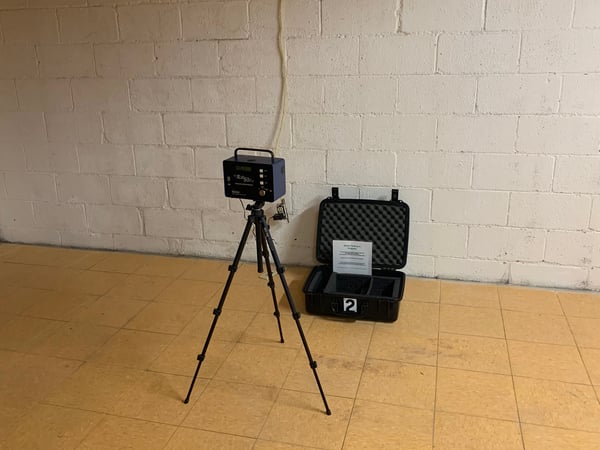Radon mitigation is any method or system used to reduce the amount of radon in a home or building.
If your home has high radon levels, you need to contact a radon inspector to install a mitigation system to lower your risk of exposure to this health hazard.
The goal of a radon mitigation system is to lower levels of radon gas in the home as much as possible.
The installation cost of a radon mitigation system will vary greatly depending on several factors.
Depending on the house, the average cost of a radon system is between $800 and $2000.
Sometimes it is less, and sometimes it is more.
In the article below, we will go over the cost of radon mitigation.
Table Of Contents
- What Is Radon?
- Three Common Types Of Radon Mitigation Systems
- What Should I Know Before Getting A Radon Mitigation System?
- What Does It Cost To Install A Radon Mitigation System?
- Radon Mitigation System Cost Factors
- Hiring A Radon Mitigation Professional
What Is Radon?
Radon is an invisible radioactive gas that has no smell and no color.
The Environmental Protection Agency (EPA) says that radon gas is the number one cause of lung cancer in people who don't smoke and the number two cause of lung cancer in the United States.
When radioactive elements like uranium and thorium break down underground, they make radon gas.
Radon gas comes up from the ground and gets into homes through cracks, joints, and drains.
The highest radon levels are typically found in the lowest level of your home.
When warm air rises in a house, it creates a vacuum that pulls radon gas up from below the foundation.
It's best to test for radon in the winter when windows are closed, and there's less airflow.
This is because more radon gets into the house when windows are closed, and there's less air movement.
Dangerous radon gas levels are above four picocuries per liter (pCi/L) or more.
Anything above this elevated level poses serious health risks and should be taken care of immediately.
However, there are no "safe radon levels."
Indoor radon levels less than four pCi/L can still be dangerous and should be brought down with radon reduction systems.

Three Common Types Of Radon Mitigation Systems
The radon mitigation system you get for your home will be one of three types.
The three most common radon reduction methods include:
- Sub-slab depressurization systems- This is an effective method where a radon professional installs a radon fan to pull the gas out from under the home's foundation and sends it outside.
- Drain tile suction systems - This method of radon mitigation uses a PVC pipe that goes through the drain tile and lets soil gases escape outside. The sump pump baskets are given covers.
- Sub-membrane systems - A plastic sheet is used to cover exposed dirt on the floor of crawl spaces. The sheet goes up the exterior wall and is sealed. A radon pipe goes through the plastic sheeting, pulls the soil gas from the crawl space, and sends it outside, lowering your radon level.
If it's not stalled properly, you could increase the radon in your home or worsen the indoor air quality issues.
What Should I Know Before Getting A Radon Mitigation System?
You should know a few things before you call a radon mitigation specialist.
In most cases, a highly trained, professional radon mitigation contractor can provide you with a quote over the phone.
Before you call professional radon mitigators, it helps to know some things about your home, such as:
- How old is your house, and what does its layout look like?
- Does the house have a crawlspace or basement?
- Did your home have radon-resistant features or a passive radon system when it was built?
What Does It Cost To Install A Radon Mitigation System?
Radon mitigation costs depend on a few things.
Prices can be more or less than the national average depending on the size and style of the home, the type of foundation floor, the climate, the geographic location, the cost of labor, the cost of permits, the cost of equipment, testing, inspection, and the type of radon system.
Old, larger homes in expensive areas will always cost more than smaller homes in an area with a lower cost of living.
When they are set up right, radon mitigation systems are made for individual homes.
Costs may be less than average for new homes with passive plumbing.
Some homes may cost more if they have additional crawl space, don't have gravel under the slab, or have fully finished lower levels.
Quality materials and work may cost a little more, but because radon is dangerous to your health, it's not a good idea to take a chance on low-quality parts and work.
If you want to compare prices between different radon companies, make sure you get a fixed quote from each one.
If a company that gets rid of radon doesn't ask you specific questions about your home, they won't be able to give you an accurate quote.
Radon Mitigation System Cost Factors
A radon mitigation system is made just for your home when done right.
This means your costs could be higher or lower than the national average, depending on the following things.
Location
Your cost of living, the number of radon experts working in your area, and any EPA rules specific to your location will all affect the costs of the radon system.
Your contractor might also suggest a different way to get rid of radon based on where your home is.
In places where it's colder, adding more ventilation can make you need more insulation on your sewer lines and water pipes and cost you more money to heat your home.

Labor and Permits
Usually, the labor cost is included in your project's total price, and like any other home improvement project, more experienced contractors will charge more.
Radon gas is dangerous to your health, so you should hire a company with a lot of experience that will ask the right questions to install the proper mitigation system and give you an accurate quote.
Ask for fixed quotes from each company before you compare prices.
Radon mitigation work might need a permit in some cities and towns.
These permits usually cost between $25 and $150, and if your project involves more electrical work, you may need more permits and inspections.
If your mitigation plan includes a radon fan, you'll need to hire a licensed electrician to wire and install it.
Testing and Inspection
If you think there might be radon in your home, you can pay a professional between $150 and $800 to do a test.
You can also purchase radon test kits at home improvement stores. Still, getting a professional to test your home for a more accurate radon concentration reading is usually a better idea.
You can also buy a radon testing kit for between $12 and $250, but the results won't be as accurate.
Foundation Improvements
Your home's foundation type will help determine the radon mitigation method required, which can impact costs.
In houses with unfinished basements, your contractor might suggest sealing the basement floor and adding an active or passive ventilation system.
This will cost upwards of $4,000.
Encapsulation may be needed for homes with a crawl space but no foundation slab. The price of encapsulating a crawl space ranges from $1,500 to $15,000.
To do this, you have to put up plastic vapor barriers and seal the edges. Then, you put PVC pipe under them to make a vacuum.
If you also have an external mitigation system installed, you usually get a price break on your total cost.
Hiring a Radon Mitigation Professional
If you are concerned about the potential presence of radon in your home, contact a professional radon inspection contractor.
Radon treatment professionals will perform professional radon testing and install a proper radon mitigation system if necessary.
To test your home for radon and potentially have a radon mitigation system installed by a professional radon mitigation company, contact the qualified radon remediation contractors at Radon Eliminator.
Radon Eliminator will look for the silent killer and get rid of it if it's found.
If your test results come back high, they will install a radon mitigation system to make your home safe to live in, all for a reasonable price.
Click the button below to schedule your Discounted Test today to ensure you and your family's safety from this silent killer.
References:
https://www.bobvila.com/articles/radon-mitigation-system-cost/
https://www.health.state.mn.us/communities/environment/air/radon/mitigationsystem.html
https://radonrepair.com/faq/radon-mitigation-costs/#2
https://www.homeadvisor.com/cost/environmental-safety/remove-radon-gas/#radon-mitigation-system-cost-factors





